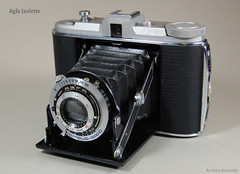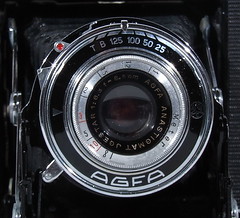Difference between revisions of "Isolette"
(Isolette series list added, Isorette-Jsorette info adde) |
|||
| Line 1: | Line 1: | ||
| − | The '''Agfa Jsolette''' is a horizontal-[[folding]] [[medium format]] camera made by [[Agfa]] Kamerawerk AG, Munich, Germany | + | The '''Agfa Jsolette''' is a horizontal-[[folding]] [[medium format]] camera made by [[Agfa]] Kamerawerk AG, Munich, Germany. This folder first came on the market as the '''Jsorette''' (also known in the market as '''Isorette''') but had a name change to '''Jsolette''' (pronounced ''Isolette'') quite soon. Then, from late 1937 the writing of the camera name changed again as '''Isolette'''. |
| − | There are two distinct models the early one and the later (post WW2) one. Operation of the Jsolette is completely manual. | + | There are two distinct models of the first Jsorette/Jsolette/Isolette series: the early one (before and during WW2) and the later (post WW2) one. Operation of the Jsolette is completely manual. All Jsorette/Jsolette/Isolette series produced between 1936/37-1950. |
| + | |||
| + | ==Isolette camera models== | ||
| + | The [[Agfa]] [[Isolette]] models include: | ||
| + | *Jsorette (also known as Isorette) 1936 (Some sources say 1937) | ||
| + | *Jsolette 1937 | ||
| + | *Isolette 1937-42 | ||
| + | *Isolette (model 4.5) 1946-50 | ||
| + | *Isolette I 1952-60 | ||
| + | *Isolette II 1950-60 | ||
| + | *Isolette III 1952-58 | ||
| + | *Isolette V 1950-52 | ||
| + | *Isolette L 1957-60 | ||
==Jsolette early model== | ==Jsolette early model== | ||
| − | The early model started life in 1936 (1937 as to some sources) as the Isorette but the name was soon changed to Jsolette, and then in late 1937 renamed again as '''Isolette'''. This means that very early 1936/37 models have Jsolette stamping on the front plate leatherette of the camera. | + | The early model started life in 1936 (1937 as to some sources) as the '''Jsorette''' ('''Isorette''') but the name was soon changed to Jsolette, and then in late 1937 renamed again as '''Isolette'''. This means that very early 1936/37 models have '''Jsolette stamping''' on the front plate leatherette of the camera. '''Isolette''' production lasted till 1942. |
This model was called in Germany during the WWII times the "Soldatenkamera" (soldiers camera) also. | This model was called in Germany during the WWII times the "Soldatenkamera" (soldiers camera) also. | ||
| Line 59: | Line 71: | ||
}} | }} | ||
|- | |- | ||
| − | |colspan=3 align="center"| Agfa Jsolette | + | |colspan=3 align="center"| Agfa Jsolette, 1936/37, from the first production year of the Isolette series |
<small>Images by Süleyman Demir {{ with permission }}</small> | <small>Images by Süleyman Demir {{ with permission }}</small> | ||
|} | |} | ||
| − | ==Jsolette late model== | + | ==Jsolette/Isolette late model== |
| − | The late model was made from 1945 till 1950. Again an unusual topcover material, this time cast-Hydronalium alloy (Nüral). There were different lens/shutter combinations possible. Other changes from the early model are to one film format only (6x6) and the addition of an accessory shoe (above the viewfinder). | + | The late model was made from 1945 till 1950 with a name Isolette. Again an unusual topcover material, this time cast-Hydronalium alloy (Nüral). There were different lens/shutter combinations possible. Other changes from the early model are to one film format only (6x6) and the addition of an accessory shoe (above the viewfinder). |
{{Flickr_image | {{Flickr_image | ||
Revision as of 10:45, 26 March 2011
The Agfa Jsolette is a horizontal-folding medium format camera made by Agfa Kamerawerk AG, Munich, Germany. This folder first came on the market as the Jsorette (also known in the market as Isorette) but had a name change to Jsolette (pronounced Isolette) quite soon. Then, from late 1937 the writing of the camera name changed again as Isolette. There are two distinct models of the first Jsorette/Jsolette/Isolette series: the early one (before and during WW2) and the later (post WW2) one. Operation of the Jsolette is completely manual. All Jsorette/Jsolette/Isolette series produced between 1936/37-1950.
Contents
Isolette camera models
The Agfa Isolette models include:
- Jsorette (also known as Isorette) 1936 (Some sources say 1937)
- Jsolette 1937
- Isolette 1937-42
- Isolette (model 4.5) 1946-50
- Isolette I 1952-60
- Isolette II 1950-60
- Isolette III 1952-58
- Isolette V 1950-52
- Isolette L 1957-60
Jsolette early model
The early model started life in 1936 (1937 as to some sources) as the Jsorette (Isorette) but the name was soon changed to Jsolette, and then in late 1937 renamed again as Isolette. This means that very early 1936/37 models have Jsolette stamping on the front plate leatherette of the camera. Isolette production lasted till 1942.
This model was called in Germany during the WWII times the "Soldatenkamera" (soldiers camera) also.
One of the very distinctive features is the topcover which is made of a plastic called "Trolitan".
There were different lens/shutter combinations possible.
It was a dual format camera. By using 2 internal mask halves it could be changed from the 6x6cm format to the 4.5x6 format.

|
| Early model Agfa Jsolette by RaúlM (Image rights) |
- Year of release: 1936/37
- Film Format: 12 exp. 6x6 or 16 exp. 4.5x6 on 120 type rollfilm.
- Shutter: Vario, Pronto, Prontor II, Compur or Compur-Rapid.
- Lens: Jgestar (later Igestar) 6.3/8.5cm, Apotar 4.5/8.5cm or Solinar 4.5/8.5cm.
- Viewfinder: optical direct vision viewfinder
The Vario shutter is on very early models which named Isorette and Jsolette, but there is no shutter name on the lens-shutter barrel.
On the early Jsolettes the front focusing element were frozen in time which is aparently typical.
|
|
| ||||||
| Agfa Jsolette, 1936/37, from the first production year of the Isolette series
Images by Süleyman Demir (Image rights) | ||||||||
Jsolette/Isolette late model
The late model was made from 1945 till 1950 with a name Isolette. Again an unusual topcover material, this time cast-Hydronalium alloy (Nüral). There were different lens/shutter combinations possible. Other changes from the early model are to one film format only (6x6) and the addition of an accessory shoe (above the viewfinder).

|
| Late model Agfa Jsolette by Hans Kerensky (Image rights) |
- Year of release: 1945
- Film Format: 12 exp. 6x6 on 120 type rollfilm.
- Shutter: Prontor, Prontor-S or Compur-Rapid.
- Lens: Apotar 4.5/8.5cm or Solinar 4.5/8.5cm.
- Double exposure prevention.
- Viewfinder: optical direct vision viewfinder
References
Bibliography
Original documents
- McKeowns, Price Guide to Antique & Classic Cameras, 12th Edition 2005.


